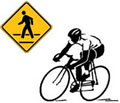 Pedestrian and bicycle accidents in the United States result in approximately 80,000 and 50,000 injuries each year, respectively. Though pedestrians and bicycles move differently, they share important characteristics as both have little protection during a roadway collision with a motor vehicle. Therefore, to minimize the risk of injury, cyclists should wear helmets and both should obey traffic laws. The responsibility to avoid collisions also rests with motor vehicle drivers, who must obey traffic signals and yield to pedestrians and cyclists when appropriate. In many accidents, the visibility of pedestrians and cyclists to drivers, and vice-versa, is of central concern.
Pedestrian and bicycle accidents in the United States result in approximately 80,000 and 50,000 injuries each year, respectively. Though pedestrians and bicycles move differently, they share important characteristics as both have little protection during a roadway collision with a motor vehicle. Therefore, to minimize the risk of injury, cyclists should wear helmets and both should obey traffic laws. The responsibility to avoid collisions also rests with motor vehicle drivers, who must obey traffic signals and yield to pedestrians and cyclists when appropriate. In many accidents, the visibility of pedestrians and cyclists to drivers, and vice-versa, is of central concern.
Expertise
We have experience in many aspects of pedestrian and bicycle accidents including:
- Pedestrian conspicuity factors
- Analysis of pedestrians and cyclists thrown by cars
- Walking speeds & perception-reaction times
- Pedestrians darting out from behind parked cars
Questions Answered
Through scientific analysis, we can help you answer pertinent questions such as:
- How fast was the car moving when it struck the pedestrian?
- Should the truck driver have been able to see the bike in time to avoid the accident?
- Would the use of a helmet have prevented the cyclist's injuries?
Case Examples
Bus Striking Boy in Crosswalk:
A young boy was crossing a street with his aunt in New York City. Before he reached the other side, he was struck by a city transit bus whose driver claimed to have had a green light. We were able to show, based on the timing of the lights and measurements of the roadway, that the bus driver had more than enough time to perceive and react to the boy in the crosswalk and could have safely stopped the bus before impact, and further that the boy was not walking unusually slowly.
Child Darting onto Roadway:
A car driver struck a boy running across a wide, busy roadway. Based on one accident investigation, it was not clear why the boy and driver did not see one another before the impact. We hypothesized that there must have been a nearby traveling vehicle between them obscuring the line of sight. A deposition witness later testified that such a car was present. This cleared the driver of negligence and resulted in a minimal settlement.
Kristopher J. Seluga, PE, is a Mechanical Engineering, Accident Reconstruction, Biomechanics, and Safety Expert with over 20 years of experience. He received his Bachelor's and Master's degrees from the Mechanical Engineering department at MIT where he worked on the development of novel three-dimensional printing technologies. Mr. Seluga is also a licensed Professional Engineer in New York and Connecticut, and has served as a member of the ANSI engineering committee for the Z130.1 and Z135 standards for golf cars and PTV's. His research interests and peer reviewed publications span the topics of Motor Vehicle Dynamics, Product Safety, and Biomechanics.
©Copyright - All Rights Reserved
DO NOT REPRODUCE WITHOUT WRITTEN PERMISSION BY AUTHOR.



 Pedestrian and
Pedestrian and 






